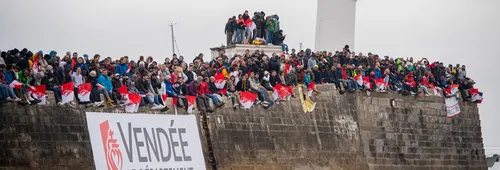Anthony Marchand: "Everything on this low will be decided by a few miles"
SUNDAY’s RACE ANALYSIS. Anthony Marchand, the French skipper of Actual Ultim 3 who completed his first solo round the world race last winter as part of the Arkéa Ultim Challenge and took part in The Ocean Race in 2023 aboard the IMOCA Biotherm alongside Paul Meilhat, Sam Davies and Damien Seguin, gives his take on the current situation in the South Atlantic and more generally on this tenth edition of the Vendée Globe.

Vendée Globe :
This Sunday, the leaders of the Vendée Globe are catching a secondary depression north of Rio de Janeiro and are starting to fly downwind towards the Cape of Good Hope. We are talking about a quite unusual situation. Might we even say that it is rather exceptional?
This small depression, which arrives at the right time, is not very violent but it will have a nice schuss effect. The leaders will take very direct routes. It is quite rare to have the opportunity to make such tight courses, so direct at this point in the globe. We can say that it is an almost perfect start to the Southern Hemisphere, for the leaders at least in any case.
Vendée Globe :
In your opinion how many will succeed in taking advantage of this depression and especially in keeping on it?
The first ten or twelve will probably succeed in setting off on it, but not all of them will succeed in holding on to it for as long. The two leaders, Charlie Dalin (MACIF Santé Prévoyance) and Thomas Ruyant (VULNERABLE) might end up being the only ones to ride it until the Cape of Good Hope. It will actually be decided by a few miles.
Vendée Globe :
Might we expect the fleet, which is already split in two, to split into three?
Indeed, but it is not too disturbing because those who drop off it will then pick up wind ahead of another big depression. This will make them ride admittedly with a little delay on those who will have sped away with the first, but with good conditions and therefore fast speeds. For the group in which we find most of the foiling boats it will clearly be longer but they will also still benefit from a fairly direct trajectory towards South Africa. In summary: the crossing of the South Atlantic should be done in good conditions even if, of course, the elastic will tighten.
Vendée Globe :
Should we expect speed records, and in particular that of the 24 hours solo and in a monohull beaten successively by Nicolas Lunven (Holcim - PRB) then Yoann Richomme (PAPREC ARKEA) in recent days, to be relevant again?
Clearly yes and it is not impossible that several of them will knock it down one after the other. In this type of situation, a few miles apart laterally, the sea and wind conditions can be very different and therefore more or less favorable. Everything will therefore depend on how each team is positioned in relation to the depression. Close to the centre, the route will inevitably be more bumpy than 200 miles further north. In addition, there are these differences in hull shapes. Between boats like those of Thomas Ruyant or Yoann Richomme and that of Sam Goodchild (VULNERABLE) which can go very fast but digs the bow in a lot, the situation will necessarily not be the same. In terms of performance but also in terms of comfort on board.
Vendée Globe :
So we can expect that there will be one or even two gaps established between the first and last at the Cape of Good Hope?
It is certain that in eight days, there is a risk of a 2,000 mile gap between the leader of the foilers and the bulk of the pack made up of boats with daggerboards. However, nothing will be set in stone. It could very well come back from behind, as was the case during the last edition. On a round the world race, the elastic regularly stretches and then relaxes. We have seen it again in recent days.
Vendée Globe :
You competed in The Ocean Race last year aboard Biotherm with Paul Meilhat of course, but also alongside Sam Davies and Damien Seguin. What is your opinion of their race so far?
It's great to see them racing. They are in the running. They seem to have boats in good condition but it's true that they haven't had any major fronts or complicated conditions since the start. This is also true for the entire fleet which is, something unheard of in a Vendée Globe, still almost complete after two weeks at sea. We will see how the rest goes. Before long, everyone will arrive in the Big South where things are bound to happen. In the event of a problem, it will then become more complicated to repair or find shelter near a coast quickly. If one of the competitors has to stop his or her race for one reason or another, there is the risk it will take a very long time to reach land. As an example, I am thinking of Loïck Peyron, who in 2008 took three weeks to return to Australia after his dismasting occurred 650 miles from the Kerguelen archipelago. In these parts, every problem quickly becomes a very big problem and in this sense, it is sometimes better to break stuff earlier in the race if it is going to happen.







